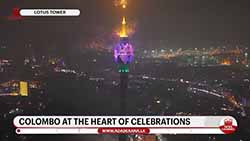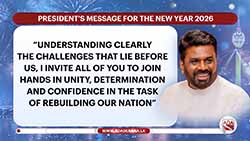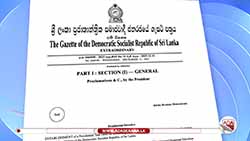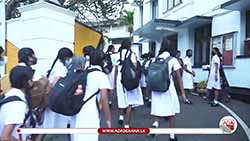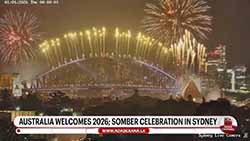Prabarkaran was a ‘psychopath’ - President
August 31, 2013 11:23 am
Sri Lanka is no longer a story of conflict, it is now a story of development, says President Mahinda Rajapaksa, in an interview with The Australian at his office in Colombo.
“I must admit we lost the propaganda battle,” Rajapaksa acknowledges ruefully, referring to the propaganda dimension of the 30-year civil war that Sri Lanka waged against the Liberation Tigers of Tamil Eelam. “I must admit we lost that very badly.”
The war ended in 2009 with the comprehensive destruction of the LTTE, especially its leadership centred on its founder Prabarkaran. The Sri Lankan Army is accused of killing civilians in the final days of the war, a charge Rajapaksa, and the Sri Lankan military, deny root and branch.
But the big result for Sri Lanka, and for the world, according to Rajapaksa, is the death of the terrorist LTTE.
Sri Lanka since then has been a nation at peace. In under a decade per capita income has trebled to $3000. In the best years during the war, tourist arrivals to Sri Lanka reached 450,000. Last year there were a million international visitors. This year there will be 1.5 million. The economy is growing by nearly 7 per cent, having had 8 per cent growth in 2010 and 2011.
“We can sustain 6 per cent,” Rajapaksa says. “Peace is the driving force behind growth. You see growth in agriculture, tourism fisheries, manufacturing, services.
“Without peace you cannot have development, and without development you cannot have peace. But the biggest achievement of all is the peace itself.
“Every day during the war you would find a dead body, sometimes many. All these youths, the Tamils who were forced to fight for the LTTE, the Sinhalese in the army, who all lost their lives. All the civilians killed. All that has stopped.”
Sri Lanka has a complex ethnic mixture with Muslim and Christian minorities. But the two biggest groups are the Buddhist Sinhalese and the Hindu Tamils. This ethno-religious division has been central to Sri Lanka’s history. But Rajapaksa is insistent there was never a Sinhalese versus Tamil war, rather the war was between the LTTE, the Tamil Tigers, and the Sri Lankan nation as a whole.
The majority of Tamils always lived not in the LTTE dominated Jaffna peninsula, but with their Sinhalese fellow citizens in the south. Hundreds of thousands of Tamils fled the LTTE controlled areas.
Rajapaksa paints the LTTE as a murderous and vicious terrorist group, and there can be little doubt of the accuracy of this basic portrait. The LTTE pioneered suicide bombings and killed two heads of government, a Sri Lankan president and an Indian prime minister, Rajiv Gandhi.
“Prabarkaran was a psychopath,” Rajapaksa says, “who had a delight in killing. He killed his own people, his own relations.”
Most of the LTTE’s targeted victims were other Tamils, Rajapaksa said, as they set about eliminating all alternative Tamil leadership to themselves.
“The LTTE was at one time so powerful, it had an army, a navy and even a small air force. Even al-Qa’ida doesn’t have that.”
Rajapaksa denies his army knowingly or intentionally killed civilians. “In a war like this, it was a war against terrorists. If we had killed civilians, civilians would never have come to us. But some 300,000 civilians fled to our side. When people tried to flee from the LTTE, the LTTE shot them.”
Now, his request to outside critics is simple: “I would invite people to come and see for yourselves.” There are regular air services to Jaffna, and the road is always busy. Travel to Jaffna and all parts of the north is free. Outsiders are welcome.
But Rajapaksa believes that the international LTTE network is still alive and well, or at least the networks among the Tamil diaspora, which formerly raised funds and waged information campaigns on behalf of the LTTE.
Controversially, he believes these networks are deeply involved in people-smuggling from Sri Lanka to Australia: “The LTTE sympathiser networks have been in this business for a long time. It was their big money-raiser. They are still doing it today. I don’t know whether the money they make goes to the LTTE today or to propaganda efforts.
“It’s easy money for them. Sometimes they even rent a fishing boat, just hire it, then use it for this (people-smuggling) purpose.”
He also accuses the LTTE networks of “using money to bribe politicians” in the West, to get them to take an anti-Sri Lankan government line.
Rajapaksa’s government is involved in the most intimate co-operation with Canberra to stop the people-smuggling trade. The President wants Australia to take a hard line by refusing to allow illegal arrivals by boat any chance of permanent settlement in Australia.
“We are very happy with Australia’s policies,” he says. “If you take (the boatpeople) in and give them all the benefits, then there will be huge pull factors.
“Everyone wants to go to Australia, to educate their children. If you tell anybody, even my ambassador, that you’ll give him citizenship, and for his sons too, he’ll be there in an instant.
“The myth is that when you get to Australia, the government will look after you, the government will give you a dole, the government will give you free medical care. We don’t want this trade to happen.”
Says Rajapaksa: “We are spending so much money to stop this. Over the last three years we have stopped more than 4000 would-be illegal immigrants (from going to Australia). Earlier, people were going to Europe, some went to Canada in ships. People want to go to the West.”
Rajapaksa is not only happy with Australia’s policies on boatpeople. He believes Australia has a history of warmth towards Sri Lanka: “We want a good relationship with Australia. Even when Australia welcomed the Bergers (a mixed race community of Sri Lankans, some of whom came to Australia decades ago) there was a lot of warmth in that relationship. That has been there for a long time. There was the Colombo Plan, there are scholarships, AusAID, the sporting links.”
Sri Lankan government figures appreciate Australia was among the first nations to commit to sending its prime minister to the Commonwealth Heads of Government Meeting to be held in Colombo in November. Canada has not yet confirmed it will attend because of human rights concerns about events at the end of the war with the Tamil Tigers.
“CHOGM will be a showcase for Sri Lanka,” Rajapaksa says. “We can show the world what Sri Lanka is really like. A lot don’t know what Sri Lanka is really like. They get a dark picture of us. But there will be a business forum, a youth forum. We also want to promote Sri Lanka as a transport hub, a shipping hub, an energy hub.”
Sri Lanka is a remarkably beautiful island. Its emergence from its long civil war is one of the most hopeful developments in a world beset by conflict and internal strife.
“I must admit we lost the propaganda battle,” Rajapaksa acknowledges ruefully, referring to the propaganda dimension of the 30-year civil war that Sri Lanka waged against the Liberation Tigers of Tamil Eelam. “I must admit we lost that very badly.”
The war ended in 2009 with the comprehensive destruction of the LTTE, especially its leadership centred on its founder Prabarkaran. The Sri Lankan Army is accused of killing civilians in the final days of the war, a charge Rajapaksa, and the Sri Lankan military, deny root and branch.
But the big result for Sri Lanka, and for the world, according to Rajapaksa, is the death of the terrorist LTTE.
Sri Lanka since then has been a nation at peace. In under a decade per capita income has trebled to $3000. In the best years during the war, tourist arrivals to Sri Lanka reached 450,000. Last year there were a million international visitors. This year there will be 1.5 million. The economy is growing by nearly 7 per cent, having had 8 per cent growth in 2010 and 2011.
“We can sustain 6 per cent,” Rajapaksa says. “Peace is the driving force behind growth. You see growth in agriculture, tourism fisheries, manufacturing, services.
“Without peace you cannot have development, and without development you cannot have peace. But the biggest achievement of all is the peace itself.
“Every day during the war you would find a dead body, sometimes many. All these youths, the Tamils who were forced to fight for the LTTE, the Sinhalese in the army, who all lost their lives. All the civilians killed. All that has stopped.”
Sri Lanka has a complex ethnic mixture with Muslim and Christian minorities. But the two biggest groups are the Buddhist Sinhalese and the Hindu Tamils. This ethno-religious division has been central to Sri Lanka’s history. But Rajapaksa is insistent there was never a Sinhalese versus Tamil war, rather the war was between the LTTE, the Tamil Tigers, and the Sri Lankan nation as a whole.
The majority of Tamils always lived not in the LTTE dominated Jaffna peninsula, but with their Sinhalese fellow citizens in the south. Hundreds of thousands of Tamils fled the LTTE controlled areas.
Rajapaksa paints the LTTE as a murderous and vicious terrorist group, and there can be little doubt of the accuracy of this basic portrait. The LTTE pioneered suicide bombings and killed two heads of government, a Sri Lankan president and an Indian prime minister, Rajiv Gandhi.
“Prabarkaran was a psychopath,” Rajapaksa says, “who had a delight in killing. He killed his own people, his own relations.”
Most of the LTTE’s targeted victims were other Tamils, Rajapaksa said, as they set about eliminating all alternative Tamil leadership to themselves.
“The LTTE was at one time so powerful, it had an army, a navy and even a small air force. Even al-Qa’ida doesn’t have that.”
Rajapaksa denies his army knowingly or intentionally killed civilians. “In a war like this, it was a war against terrorists. If we had killed civilians, civilians would never have come to us. But some 300,000 civilians fled to our side. When people tried to flee from the LTTE, the LTTE shot them.”
Now, his request to outside critics is simple: “I would invite people to come and see for yourselves.” There are regular air services to Jaffna, and the road is always busy. Travel to Jaffna and all parts of the north is free. Outsiders are welcome.
But Rajapaksa believes that the international LTTE network is still alive and well, or at least the networks among the Tamil diaspora, which formerly raised funds and waged information campaigns on behalf of the LTTE.
Controversially, he believes these networks are deeply involved in people-smuggling from Sri Lanka to Australia: “The LTTE sympathiser networks have been in this business for a long time. It was their big money-raiser. They are still doing it today. I don’t know whether the money they make goes to the LTTE today or to propaganda efforts.
“It’s easy money for them. Sometimes they even rent a fishing boat, just hire it, then use it for this (people-smuggling) purpose.”
He also accuses the LTTE networks of “using money to bribe politicians” in the West, to get them to take an anti-Sri Lankan government line.
Rajapaksa’s government is involved in the most intimate co-operation with Canberra to stop the people-smuggling trade. The President wants Australia to take a hard line by refusing to allow illegal arrivals by boat any chance of permanent settlement in Australia.
“We are very happy with Australia’s policies,” he says. “If you take (the boatpeople) in and give them all the benefits, then there will be huge pull factors.
“Everyone wants to go to Australia, to educate their children. If you tell anybody, even my ambassador, that you’ll give him citizenship, and for his sons too, he’ll be there in an instant.
“The myth is that when you get to Australia, the government will look after you, the government will give you a dole, the government will give you free medical care. We don’t want this trade to happen.”
Says Rajapaksa: “We are spending so much money to stop this. Over the last three years we have stopped more than 4000 would-be illegal immigrants (from going to Australia). Earlier, people were going to Europe, some went to Canada in ships. People want to go to the West.”
Rajapaksa is not only happy with Australia’s policies on boatpeople. He believes Australia has a history of warmth towards Sri Lanka: “We want a good relationship with Australia. Even when Australia welcomed the Bergers (a mixed race community of Sri Lankans, some of whom came to Australia decades ago) there was a lot of warmth in that relationship. That has been there for a long time. There was the Colombo Plan, there are scholarships, AusAID, the sporting links.”
Sri Lankan government figures appreciate Australia was among the first nations to commit to sending its prime minister to the Commonwealth Heads of Government Meeting to be held in Colombo in November. Canada has not yet confirmed it will attend because of human rights concerns about events at the end of the war with the Tamil Tigers.
“CHOGM will be a showcase for Sri Lanka,” Rajapaksa says. “We can show the world what Sri Lanka is really like. A lot don’t know what Sri Lanka is really like. They get a dark picture of us. But there will be a business forum, a youth forum. We also want to promote Sri Lanka as a transport hub, a shipping hub, an energy hub.”
Sri Lanka is a remarkably beautiful island. Its emergence from its long civil war is one of the most hopeful developments in a world beset by conflict and internal strife.






